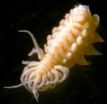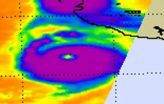A hot species for cool structures
Complex proteins in 3-D thanks to simple heat-loving fungus
2011-07-22
(Press-News.org) A fungus that lives at extremely high temperatures could help understand structures within our own cells. Scientists at the European Molecular Biology Laboratory (EMBL) and Heidelberg University, both in Heidelberg, Germany, were the first to sequence and analyse the genome of a heat-loving fungus, and used that information to determine the long sought 3-dimensional structure of the inner ring of the nuclear pore. The study was published today in Cell.
The fungus Chaetomium thermophilum lives in soil, dung and compost heaps, at temperatures up to 60oC. This means its proteins – including some which are very similar to our own – have to be very stable, and the Heidelberg scientists saw this stability as an advantage.
"There are a number of structures that we couldn't study before, because they are too unstable in organisms that live at more moderate temperatures," explains Peer Bork, who led the genome analysis at EMBL. "Now with this heat-loving fungus, we can."
The scientists compared the fungus' genome and proteome to those of other eukaryotes – organisms whose cells have a nucleus – and identified the proteins that make up the innermost ring of the nuclear pore, a channel that controls what enters and exits a cell's nucleus. Having identified the relevant building blocks, the scientists determined the complex 3D structure of that inner ring for the first time.
"This work shows the power of interdisciplinary collaborations," says Ed Hurt, who led the structural and biochemical analyses at Heidelberg University: "the nuclear pore is an intricate biological puzzle, but by combining bioinformatics with biochemistry and structural biology, we were able to solve this piece of it for the first time."
The scientists have made C. thermophilum's genome and proteome publicly available, and are confident that these will prove valuable for studying other eukaryotic structures and their interactions, as well as general adaptations to life in hot places. Such knowledge could potentially lead to new biotechnology applications.
INFORMATION:
Published online in Cell on 22 July 2011.
END
ELSE PRESS RELEASES FROM THIS DATE:
2011-07-22
Building a battery-powered land speed vehicle capable of achieving a speed of 400+ miles per hour requires innovative components, corporate partnerships, hours of diligent preparation and a powerful supercomputer.
A team of engineering students at The Ohio State University's (OSU) Center for Automotive Research (CAR) recently began running aerodynamics simulations at the Ohio Supercomputer Center (OSC), one of the first steps in the long and careful process of researching, designing, building and racing the fourth iteration of their record-breaking, alternative-fuel streamliner. ...
2011-07-22
On July 10, The Denver Post published two side-by-side op-ed pieces on hydraulic fracturing. One by Dave McCurdy, president and CEO of the American Gas Association, argued that the natural gas extraction process has led to an energy revolution in the U.S., one that reduces the nation's dependence on foreign energy, creates domestic jobs and safely helps the nation meet its diverse and growing energy needs while reducing its carbon footprint.
The second piece by Sam Schabacker, a senior organizer for the consumer advocacy organization, Food & Water Watch, paints a different ...
2011-07-22
(Santa Barbara, Calif.) –– Scientists at UC Santa Barbara and other institutions say their new research is expected to profoundly affect the field of ecology and can assist the management of ecosystems, including forests, lakes, and oceans. And it's all because of parasites.
The research, published this week in the journal Science, includes parasites in a comprehensive study of ecosystems. By doing so, the scientists say they have revealed new ecological rules.
"The major finding of our research is that all types of animals –– parasites or otherwise –– appear to follow ...
2011-07-22
Operations research models developed by a team at the Georgia Institute of Technology helped CARE International pick three locations worldwide to supply relief quickly to victims of earthquakes, floods, and other natural disasters, according to a paper in a journal of the Institute for Operations Research and the Management Sciences (INFORMS®).
"Pre-Positioning of Emergency Items for CARE International" is by Serhan Duran, currently at the Middle East Technical University in Ankara Turkey, and by Marco A. Gutierrez and Pinar Keskinocak of the H. Milton Stewart School ...
2011-07-22
COLUMBIA, Mo. ¬— While some members of Congress and others are trying to repeal the healthcare reform law that was passed in 2010, known as the "Patient Protection and Affordable Care Act," medical providers have begun to implement requirements as the law slowly phases in over the next several years. For reform to be successful, one University of Missouri public health expert has determined that professional associations for psychologists and other medical providers need to be at the forefront of the planning stages, and that everyone, including providers and patients, ...
2011-07-22
In the wake of the devastating Japanese tsunami, the 2010 Haitian earthquake, and the recent threat of pandemic flu, a new issue of the journal Interfaces: The INFORMS Journal on the Practice of Operations Research is dedicated to improving responses to disasters, health crises, and acute public issues, according to the Institute for Operations Research and the Management Sciences (INFORMS®).
The Interfaces special issue on Humanitarian Logistics: Doing Good with Good O.R. is edited by Ozlem Ergun, Pinar Keskinocak, and Julie Swann, the directors of the Georgia Tech ...
2011-07-22
A new image and video of major Hurricane Dora were released today from NASA's Goddard Space Flight Center in Greenbelt, Md.
Satellites provide a bird's eye view of a hurricane's eye, and NASA noticed Hurricane Dora's eye from several of them. Infrared imagery from NASA's Aqua satellite provided forecasters with a clear view of a cloud-free eye in hurricane Dora as she strengthens near Category 5 status today. Meanwhile the GOES-11 satellite captured a movie of Dora's intensification over the last two days that clearly shows a developing eye.
The Atmospheric Infrared ...
2011-07-22
ANN ARBOR, Mich.---The results of a study on candidates' use of Twitter in the 2010 midterm elections suggest that Republicans and Tea Party members used the social medium more effectively than their Democratic rivals.
The University of Michigan study, among the first to examine the Tea Party's social media strategies, also showed that analyzing Twitter activity can lead to good predictions of election winners.
Various social media tools have become a key part of campaign strategies in recent years. In 2010, nearly a quarter of online adults used social networks including ...
2011-07-22
COLUMBUS, Ohio – The development of a new cell-culture system that mimics how specific nerve cell fibers in the brain become coated with protective myelin opens up new avenues of research about multiple sclerosis. Initial findings suggest that myelin regulates a key protein involved in sending long-distance signals.
Multiple sclerosis (MS) is an autoimmune disease characterized by damage to the myelin sheath surrounding nerve fibers. The cause remains unknown, and it is a chronic illness affecting the central nervous system that has no cure.
MS has long been considered ...
2011-07-22
Rockville, Md. — Several reports indicate that prolonged viewing of mobile devices and other stereo 3D devices leads to visual discomfort, fatigue and even headaches. According to a new Journal of Vision study, the root cause may be the demand on our eyes to focus on the screen and simultaneously adjust to the distance of the content.
Scientifically referred to as vergence-accommodation, this conflict and its effect on viewers of stereo 3D displays are detailed in a recent Journal of Vision article, The Zone of Comfort: Predicting Visual Discomfort with Stereo Displays. ...
LAST 30 PRESS RELEASES:
[Press-News.org] A hot species for cool structures
Complex proteins in 3-D thanks to simple heat-loving fungus


